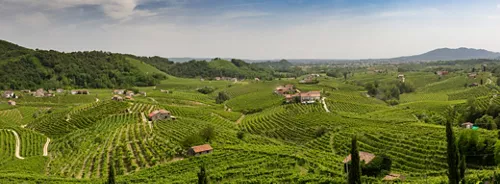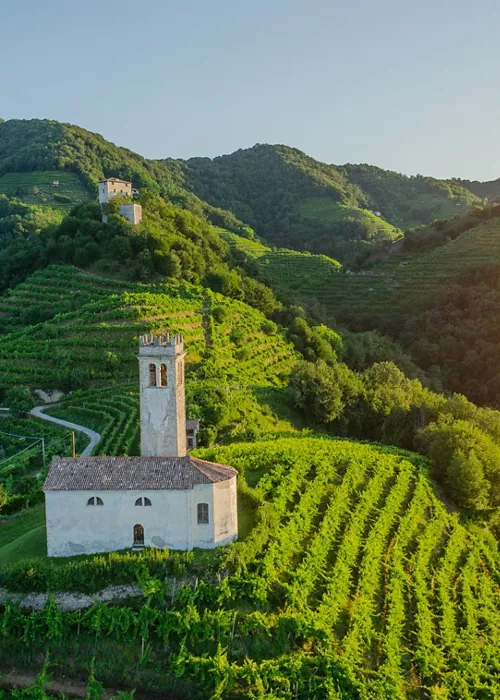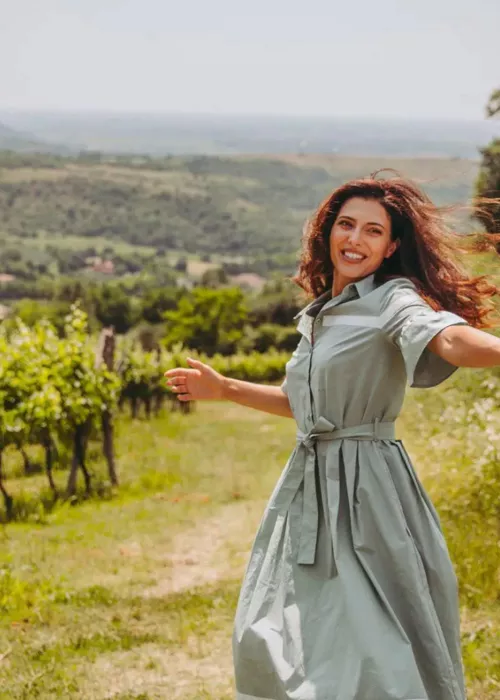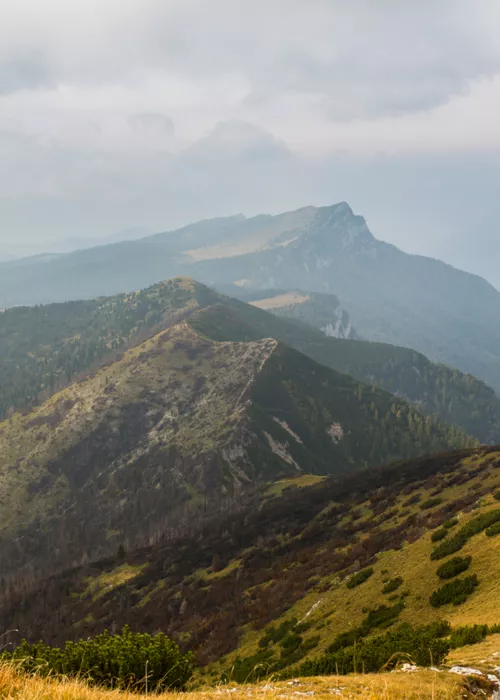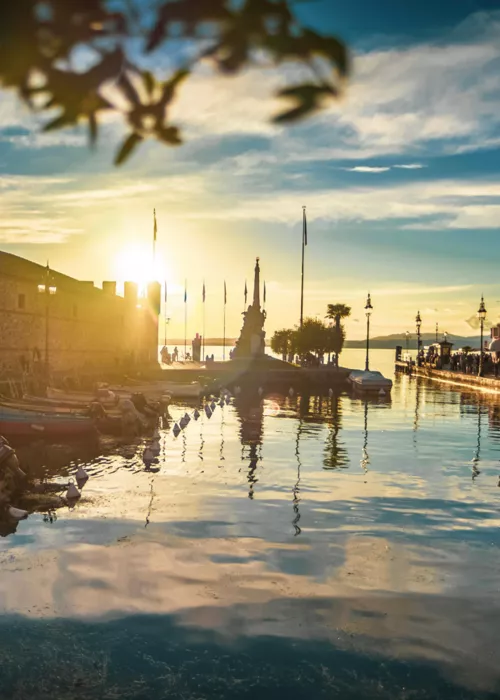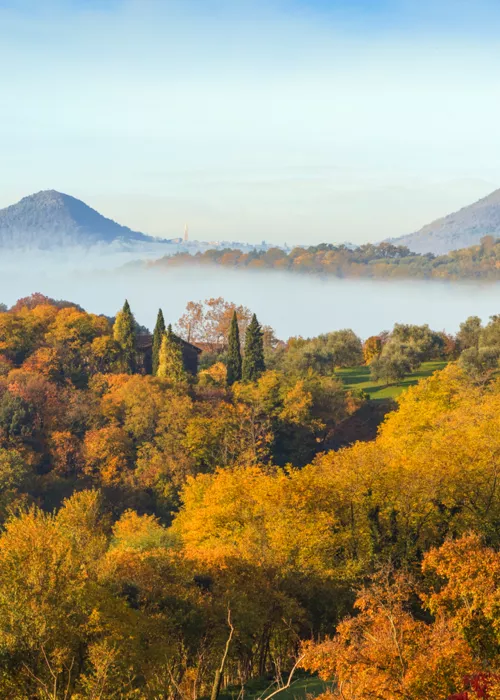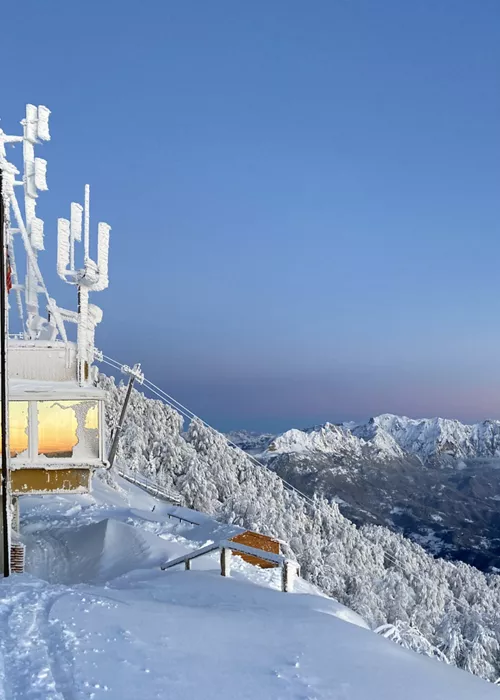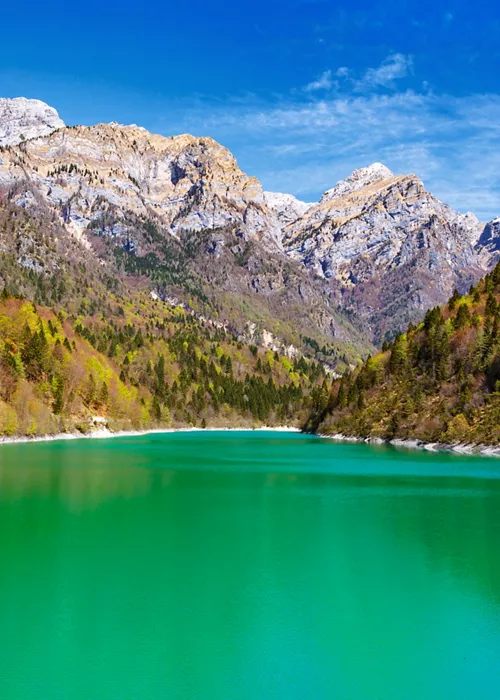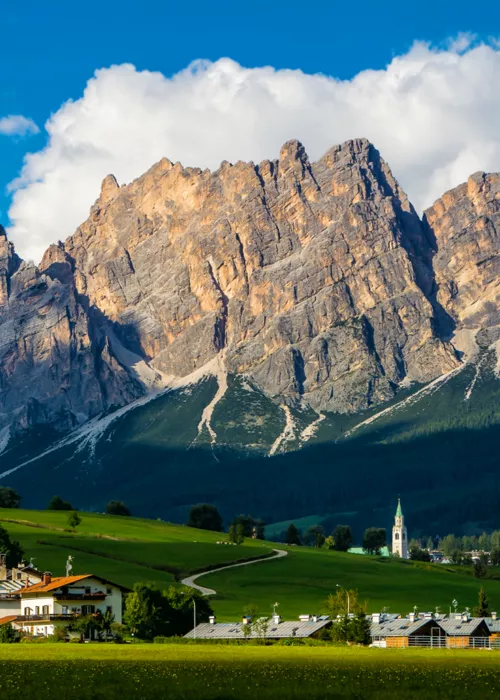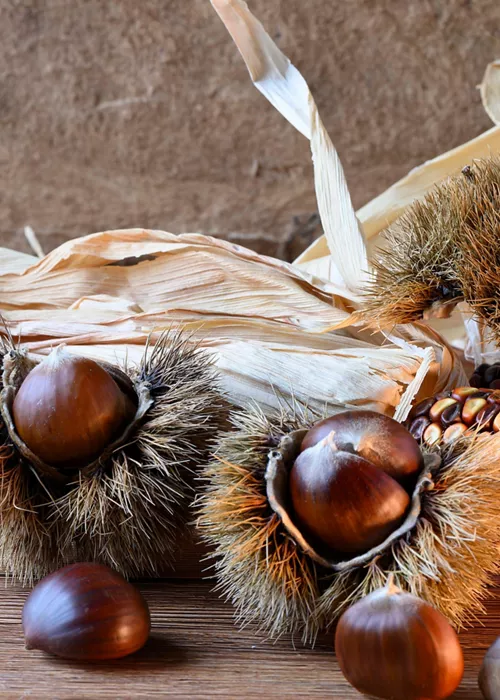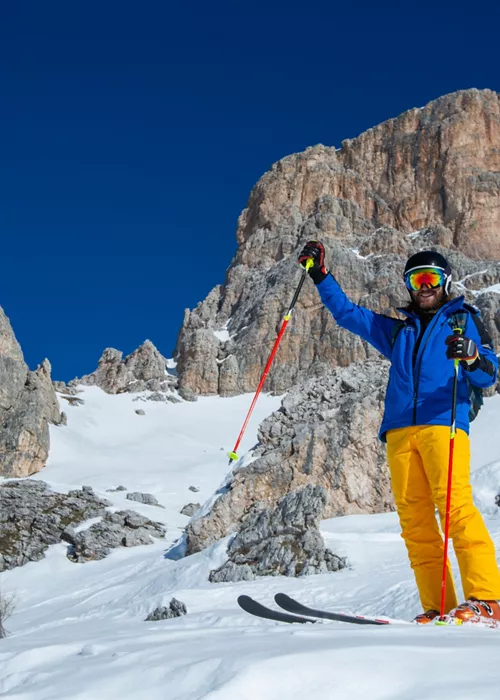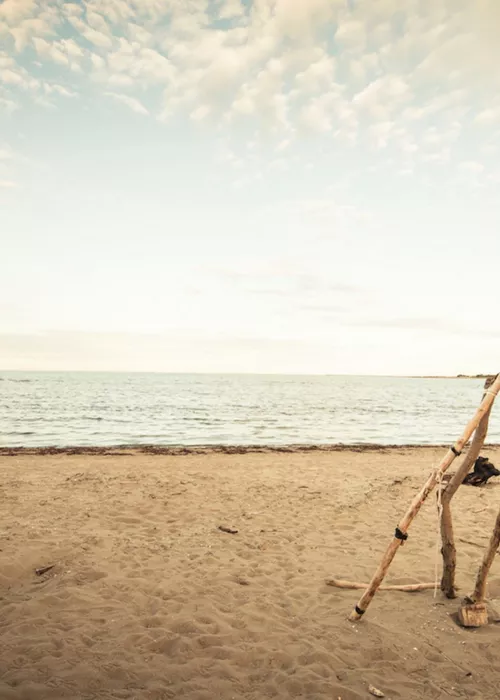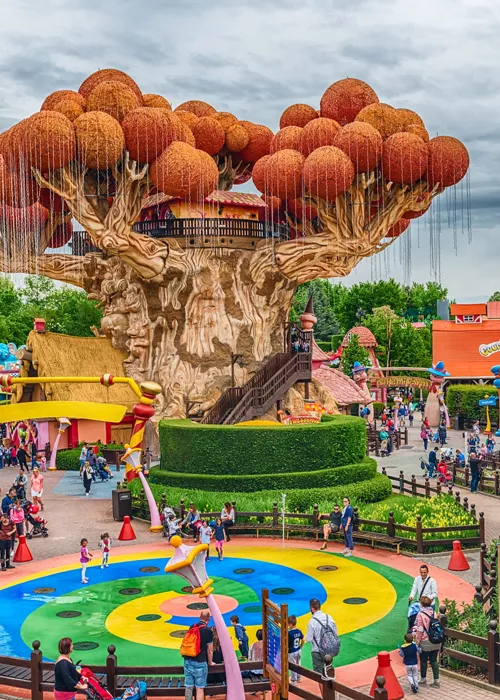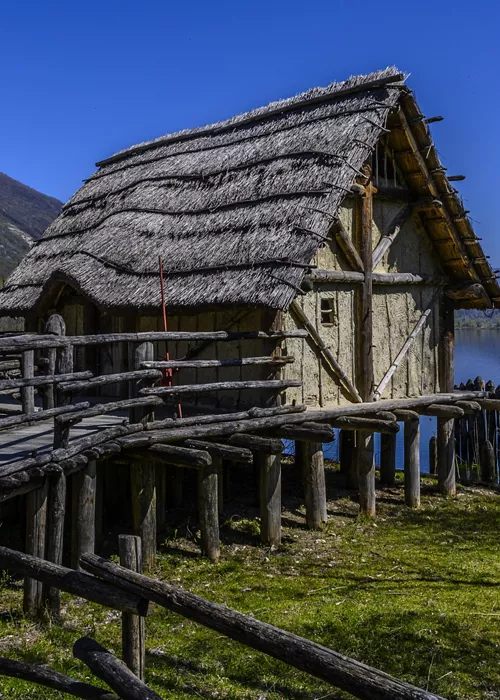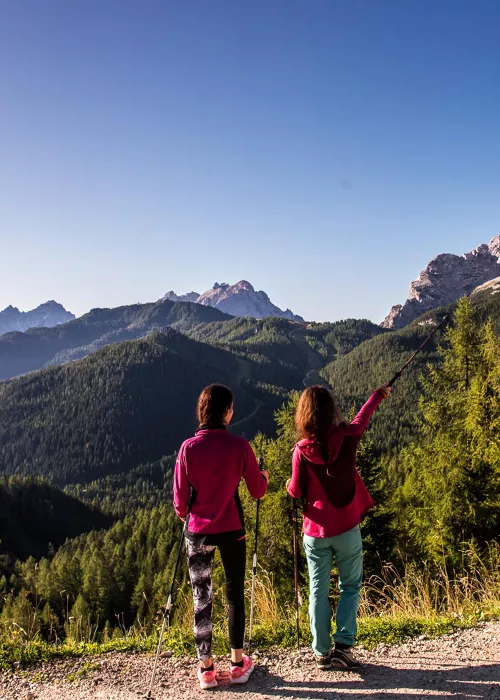The 3 Beautiful Medieval Villages of Central Veneto
11 minutes

Preserved medieval towns, hilltop fortifications, spectacular hilltop hamlets so beautiful they became famed by the works of poets and artists. Here’s where to go in the stunning plains and mountainous vistas of Central Veneto.
Montagnana – Medieval walls and prized prosciutto

Kilometres of walls and towers surrounding houses in colourful rows and palatial Venetian villas – the medieval complex of Montagnana houses a mix of beautiful architectural layers.
Top 5 things not to miss
- Walk around the medieval walled village, surrounded by 24 towers and four gates.
- Visit Piazza Comunale and see the Cathedral of Santa Maria Assunta and Palazzo del Monte di Pietà.
- Learn about Montagnana from the late Neolithic to the modern day in the Giacomelli Civic Museum.
- Climb the Castle of San Zeno tower for views over the medieval walls.
- Food/Wine to taste: Montagnana prosciutto, Veneto Berico-Euganeo DOP.
A waiter in a restaurant first told me what defines Montagnana. "Here we have two things: the old walls and prosciutto", offering me a plate as an appetiser. That was my first introduction to the borgo.
The first thing I saw was Montagnana's magnificent complex from the outside. These 13th-century medieval walls are some of Italy's best preserved – a majestic ground fortification comprised of 24 towers and four gates reaching up to 8 metres high. The still-standing, intact barricade stretches for 2km, and the concaved grassy mounds are the hollows of the old moat. When you enter Porta Legnago or Porta Padova in particular, you feel like you are entering another realm.
Porta Padova is the oldest fortified entrance, and where stands Castel San Zeno, now home to the Civic Museum. It's filled with archaeological finds and exhibits detailing the comune's history and whose tower you can still climb for unparalleled, elevated views over the great walls. It's the oldest section of the military complex, and my walk along the wall revealed changes over the ages. The third gate Porta Vicenza opened later in 1504, and the fourth, Porta XX Settembre, in 1885, connected to the railway station.
This Central Veneto historic town has the Borghi piu Belli d’Italia and Touring Club Italiano Orange Flag distinctions. More than just the remains of a fortified complex, a walk inside reveals a pretty town filled with lanes of colourful houses and older residential dwellings that merge with the wall. The quadrilateral layout of streets converges in the middle, opening onto a vast square surrounded by some of the village's showpiece architecture.
Piazza Comunale is the heart of Montagnana. I walked around the architecturally embossed square, taking pictures of almost every building that lined it, parts of the medieval walls and towers poking through behind. The star structure is the Cathedral of Santa Maria Assunta, one of Montagnana's most beautiful. It was built in 1431 and not finished until 1502, giving it a unique appearance that combines sharper, abstract Gothic features with harmonious Renaissance fixtures. It stands opposite the landmark Palazzo Valderi with its ornate columned arcade, neighboured by the elaborate arcade on Via Carrarese. Altogether, a timeline of a town which grew from its medieval military foundations into a flourishing township dotted with Venetian-era villas.
It was lunchtime, and I noticed cafes offering the tasty Piadina flatbread filled with Montagnana's speciality Prosciutto (ham). It has the Veneto Berico-Euganeo DOP (Protected Designation of Origin), produced only in the fifteen municipalities in the provinces of Verona and neighbouring Padua and Vicenza. A product with this trademark is a quality stamp of local production. The dry-cured ham is aged to perfection in a controlled environment that produces a distinct aroma and taste. You can taste it in restaurants as an appetiser, get a little sample as part of an aperitivo or follow other visitors carrying the green bags of the family-run Prosciuttificio, Attilio Fontana, just outside of the city walls. The town celebrates its speciality in the 'Festa del Prosciutto Veneto' every May.
You know you're in a great destination when there are layers of history to explore and a celebrated food speciality to indulge in. The waiter was right.
Montagnana: Useful Information
Best time to visit: June to September are the warmest months in Montagnana, perfect for al fresco dining in the main square and blue-sky views from the tower. April-May and October see comfortable temperatures still reaching 19°C. The Civic Museum is closed on Monday and Tuesday.
How to get there: Montagnana is between Venice and Verona. A train from both cities takes around 1 hour 30 minutes to 2 hours on average via the Trenitalia service. There are also 1-hour trains to Padova. A bus connects Soave with Montagnana, with a change in San Bonifacio and a total journey time of 1 hour.
Arquà Petrarca – The medieval village home to poets

The hilltop village, made famous by an Italian poet, is a charming cobblestoned medieval hamlet set to a backdrop of unfurling green slopes and mountain trails.
Top 5 things not to miss
- Wander the sloping old streets of the preserved medieval village built upon two hills.
- Visit the house and tomb of poet Francesco Petrarca who called Arquà Petrarca home.
- Shop for local products or sample regional wines at one of the three village Enotecas.
- Take a hike and follow the Atestino trail for elevated village views across the Euganean hills.
- Food/Wine to taste: The local ragu, bigoli with meat sauce.
The car wound up through the dense foliage, where hills with pyramids tips poke above - the way to Arquà Petrarca is paved with green. The village sits on a hilly outcrop (arquata is the Latin for arch), its laneways curving, ascending, sloping, and descending. Every corner has a different viewpoint, wine bars with panorama terraces and stairways leading to another village layer. Making the list of the most beautiful villages in Italy (Borghi più Belli d’Italia), and the Italian Touring Club Orange Flag, Arquà Petrarca is favoured by cyclists and hikers who cross through hills and rest within.
Arquà Petrarca is as quaint as can be. Its preserved medieval hamlet in light golden stone, rural dwellings, water fountains and cobblestone stepped lanes, later inhabited by the Venetian nobility and their grand villas. A scenery that has been immortalised by the Italian poet Francesco Petrarca, who spent the last years of his life here, a retreat he recalled fondly, and whom this place is named after. People arrive to see how his words match the landscape that became a magnet for other artists.
From Via Roma, I went down the stone steps of Via Zane to the 15th-century medieval landmark of Palazzo Contarini and the adjacent Parish Church of Santa Maria Assunta, where Petrarca's marble tomb stands outside. I joined others here to marvel at the uncovered wall frescos within. Walking back on the almost circular road that connects Via Zane to Via Fontana, I passed perfectly layered stone houses and cottages with whitewashed walls, merging into Strada Provinciale, full of wine bars and stores.
The weather is ideal for al fresco dining to watch people passing the steep Via Ventolone slope where I would start my hike. At the upper village, at the top of the hill, travellers enter the restaurant on the square or follow the path to the wine bar tucked away behind the 12th-century Loggia del Vicari – the one administration centre of the village where heads of medieval ruling families would meet. I order the local speciality ragu, bigoli with meat sauce, perfect with a glass of Veneto wine.
On its fringes, the Atestino trail is the closest hiking trail to the village. Well-known hikes and viewpoints like Pianoro del Mottolone, Sentiero del Monte Venda n.9 and Sentiero n. 12 del Monte Fasolo, the hilltop villas of Villa Barbarigo and Villa Beatrice d'Este and the archaeological UNESCO site of lake Laghetto della Costa are around a one-hour radius by car from the centre of Arquà Petrarca. Natural beauty spread far and wide, a testament to the village's spectacular setting. Atestino is a circular trail around the borgo covering close to 20km, on a five-hour journey through the passes of Mount Rusta and the Marlunghe ridge with views to Mount Cero and Mount Castello.

It's also the path that eventually brings you to Petrarch's garden-set home at one of the entrances to the village, where he lived from 1370 until 1374, symbolically completing a journey into what draws people to this place, described so perfectly by the poet as "rich of green vegetation and full of peace".
Arquà Petrarca: Useful Information
Best time to visit: June to September are the warmest months, with July being the hottest. May and October are the cooler seasons, and the Jujube Festival takes place during the first two Sundays of October.
How to get there: The closest city is Venice. The nearest train station to Arquà Petrarca is Monselica, around 5 minutes away by taxi – a 1 hour 20-minute train ride from Venice. Local buses connect to some neighbouring villages such as Montagnana.
Asolo – Romantic beauty and renowned prosecco

The romantic landscape of the “Town of a Hundred Horizons” is a mesh of medieval relics, stunning streets, pretty palazzos, and the residents of artists who called Asolo home. A ‘Borghi più Belli d’Italia’ nestled upon the rolling hills.
Top 5 things not to miss
- Wander the hilltop medieval and Venetian village known as the “Town of a Hundred Horizons”.
- Visit artists' homes, like Villa Freya, the residence of English writer Freya Stark.
- See exhibits on Asolo’s history in the Civic Museum in Palazzo della Ragione.
- Climb to the “Rocca” - The symbol of Asolo and the best place for sweeping views over the village.
- Food/Wine to taste: Prosecco Asolo DOCG, produced in the surrounding vineyards.
Central Veneto is full of charming hamlets on gentle hills, and Asolo is one of the most beautiful. This mountain-set destination was described as the "Town of a Hundred Horizons" by the Italian poet Giosué Carducci precisely for its beautiful setting, perched between the rolling Venetian plains and the eastern Alps.
A prime landscape, Asolo has been inhabited since prehistoric times, emerging as an important Roman Municipium before being ruled by the Ezzelini, Scaligeri, Carraresi, and Trevigiani families during the Middle ages. Asolo grew under the Venetian Republic, a canvas of inspiration for writers and poets, painters and musicians, actors and intellectuals, and a magnet for travellers.
Today, it retains the romantic feel - pretty fountain-filled squares at the end of winding streets lined with colourful Casas and stone brick houses, manicured gardens presided over by grand villas and the remnants of Asolo Castle poking through, like the clock tower.

Art and splendour are everywhere. Even when I check into my apartment hotel – a restored 16th-century villa with preserved frescos. You'll see the kind in churches, palazzos, and walls around the village, a delicate print framed under a modern paint layer. Artistry fills the streets – a bougie mix of painters, sculptures, designers, and fashion boutiques occupying the spaces within the arcades. A creative legacy lingers in residences and churches, castles, and cathedrals.
You can visit Villa Freya, the home of English writer and traveller Freya Stark, who retired in Asolo in the 1970s and spent her final years there. The remains of the foundations of a roman theatre are still visible in the garden of the house. The theatre in Asolo's Cornaro Castle grounds is named after Italian actress Eleanor Duse who also chose Asolo as her final resting place. The Cathedral houses altarpiece works by Renaissance Venetian painters, including the 'Assunta' by Lorenzo Lotto, 'St Jerome at Pulpit' by Lazzaro Bastiani and 'Saint Prosdocimus' by Pietro Damini. Palazzo della Ragione, a 15th-century house turned town museum, is filled with artefacts from the Prehistoric era to the Renaissance, the cathedral's treasury, portraits of noblemen and queens, and exhibits dedicated to Eleonora Duse, Freya Stark and Venetian Queen Cornaro who ruled here in the 15th century.
Asolo's old streets may be artful, but there's another perspective. The Rocca monument on top of Monte Ricco at 310m is a symbol of Asolo. It's also the platform for a panorama over this stunning enclave, the old town nestled in the folding hills with views from the Dolomites to Venice. The fortification dates from the 12th to the beginning of the 13th century, although it was constructed on a settlement site from the 10th-12th century, marking Asolo's very beginnings.
I end a day of exploring by returning to the streets, filled with people in cafes and wine bars, a glass of the borgo's revered bubbles in hand. If the village wasn't delectable enough, Asolo is also known for its prime prosecco production – with a DOCG (designation of origin and guaranteed) distinction in the Veneto wine region. The vineyards surround the village. I opted for prosecco tasting in the 'Asolo Wine Shop' where owner Roberta talked me through four varieties. Whether you opt for Extra Brut, Brut, Extra Dry or Dry, with varying levels of sweetness and carbonation, it's a sparking way to end your time in the village dubbed the 'Pearl of the Veneto'.
Asolo: Useful Information
Best time to visit: The warmest months are June to August, and the shoulder seasons of April-May and September-October see cooler temperatures, but they are still perfect for al fresco dining. The famed Asolo Art Film Festival typically takes place in June. The Rocca, as well as the Civic Tower, are only open on weekends.
How to get there: The closest city is Treviso, accessible via a 40-minute train from Venice. From Treviso, take bus 112 towards Bassano del Grappa, which reaches Asolo after approximately 1 hour.
Article written about the experience of Becki Enright.


